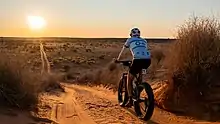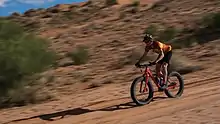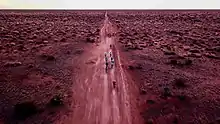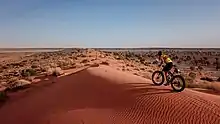Simpson Desert Bike Challenge
The Simpson Desert Bike Challenge (SDBC) is an annual staged mountain bike race held in the Simpson Desert of Australia.[1][2] First held in 1987, the SDBC is run by the non-profit organisation Desert Challenge Inc[3][4]
| Simpson Desert Bike Challenge | |
|---|---|
 Simpson Desert Bike Challenge competitor | |
| Status | Active |
| Location(s) | Simpson Desert |
| Coordinates | 25.0466°S 136.7435°E |
| Country | Australia |
| Inaugurated | 1987 |
| Most recent | 2019 |
| Organized by | Desert Challenge Inc. |
| Website | desertchallenge |


The SDBC covers between 500 and 600 kilometres and lasts five days. The times taken to finish each stage are aggregated to determine the overall winner. Although the course changes every year, the SDBC typically starts in South Australia and finishes in Birdsville, Queensland. The route takes riders and support crews through the largest parallel sand dune desert in the world.[5]
Riders of all ages and abilities are allowed to participate. For example, past competitors have included a cop,[6] a coffee shop owner,[7] and an IT manager.[8]
The SDBC is unofficially the world's longest-running mountain bike stage race.[9] According to several endurance event rating sites, the SDBC race is one of the world's toughest endurance events.[10][11][12]
There is no prize pool for the SDBC .[13] All proceeds are donated to charity.[1] Since 2008 the committee has donated the proceeds to the Royal Flying Doctor Service of Australia (RFDS) [14][15] Money is raised for the RFDS through online fundraising of riders, a post-race auction, as well as donations collected during the event for (fun) fines. So far more than $312,000 have been raised by the organization, which is run by a group of volunteers and incorporated in South Australia as the non-for-profit organization Desert Challenge Inc.[16]
Race location and routes
The SDBC"[17] crosses the Munga-Thirri–Simpson Desert National Park (proclaimed a national park on 26 November 2021,[18][19] formerly Munga-Thirri—Simpson Desert Conservation Par and the Munga-Thirri-Simpson Desert Regional Reserve[20]) a large area of dry, red sandy plain and dunes in the Northern Territory, South Australia and Queensland.[21] The course varies from year to year as several routes have been surveyed and developed.[22]
The SDBC it is basically a moving race village, comprising riders and their support crews, 4 wheel drive vehicles and event crew.[1]
The race routes traverse tracks that were constructed for oil exploration in the 1970s.[23] In wet conditions, track closures are common and the race may need to be diverted.[24]
Race concept and purpose
There are no settlements or service locations between the SDBC start and finish lines. As the event crosses protected conservation areas, it has to comply with a range of rules designed to protect the environment.[25] The SDBC follows a format in which riders are always travelling between a front and rear convoy.
Each day, riders complete a morning and afternoon stage.[26]
- Race distance: 485–570 km (301–354 mi)
- Race duration: 5 days (9 or 10 stages; on day five there are one or two stages)
- Stage distances: ~ 75 km morning, ~ 45 km afternoon.
Due to the significant daily distances and the requirement for riders to arrive at night camp before dark, the SDBC has a minimum speed requirement. Riders must maintain a minimum average of 12 km (7.5 mi) per hour to stay ahead of the rear convoy – which is led by the sweep vehicle. If caught by the “sweep,” riders have to take a lift to the end of that stage. Riders are allowed to restart the next stage in the afternoon or the next morning.
All riders who complete every stage of the SDBC get the “100% SDBC medal.” The average percentage of riders winning the 100% medal is 36% – although there have been years where no rider completed the course (e.g. 2008[27]) as well as one year where no rider was swept at all (2016[4]).
Water stops are located approximately every 20 km (12 mi) and every rider has to stop and collect water. At the start and end of every stage, the weight of each rider is recorded to manage risks related to dehydration. Beyond water stops, riders must be self-sufficient.[28]
Medical teams are present at each water stop to monitor the physical and mental status of the riders.
[29] Support vehicles must travel in either the front convoy ahead of the riders or in the rear convoy behind the Sweep vehicle. Vehicles experiencing difficulties crossing dunes can expect prompt assistance. Regulations require each vehicle to have UHF radio and a high visibility safety flag.[30]
Event origins
Source

In 1988, Jack and Mary Mullins organised and directed the first Simpson Desert Cycle Classic In 1988. The event raised money for the Paraquad Association.
The Mullins ran the SDBC until 1994, when Rod and Loz Townsend took it over. During those years an association with the Paraplegic Benefit Fund was created as a recipient charity. The Townsends managed the event until 2001.
In 2006 a management committee for the SDBC was elected. This committee established Desert Challenge Inc..
Race results
| Year | Overall Winners | 100% Finishers | ||
|---|---|---|---|---|
| 1st Place | 2nd Place | 3rd Place | No. of riders who completed all race stages / overall no. of riders | |
| 2021 | n/a (cancelled due to COVID-19 Pandemic) | |||
| 2020 | n/a (cancelled due to COVID-19 Pandemic) | |||
| 2019 | Rasmus Altenkamp | Michael Liebert | Chris Baillie | 5/15 |
| 2018 | Derek Ragless | Eckart Altenkamp | Aurelia Strozik | 6/18 |
| 2017 | Eckart Altenkamp | Graham Hancox | Adam Gowlett | 4/11 |
| 2016 | Justin Morris | Jason Morrison | Peter Moore | 20/20 |
| 2015 | Paul Schroder | Peter Moore | Ollie Klein | 10/20 |
| 2014 | Bruce Wood | Bill Somerville | Michael Chidgey | 9/20 |
| 2013 | Ronn Slusser | Lynton Stretton | Chris Baillie | 15/22 |
| 2012 | Alan Keenleside and Murray Rook | n/a | Lynton Stretton | 7/17 |
| 2011 | Paul Schroder | Ken Glasco | Neil Thies | 13/17 |
| 2010 | Ron Whitehead | Simon Honore | Lynton Stretton | 12/24 |
| 2009 | Alan Keenleside | Lynton Stretton | Jason Dreggs | 1/30 |
| 2008 | Lynton Stretton | Warren Quinn | Heinz von Holzen | 0/12 |
| 2007 | Bruce Wood | Andrew Koop | Matthias Axt | 2/17 |
| 2006 | Ed Bourke | Heinz von Holzen | Jason Iwanow | 5/11 |
| 2005 | Jaap Viergever | Anthony Brattolli | John Dermody | 6/24 |
| 2004 | Jaap Viergever | Craig Peacock | Leon Fisher | 18/30 |
| 2003 | Adrian Laing | Kim Proctor | Carl Barrow | 13/16 |
| 2002 | Leon Fisher | Carl Barrow | Trevor Best | 3/22 |
| 2001 | Leon Fisher | Ed Bourke | Ian Langstaff | 21/32 |
| 2000 | Jack Oldfield | Ed Bourke | Michael Rueger | 4/54 |
| 1999 | Jack Oldfield | Ed Bourke | Ben Edols | 2/41 |
| 1998 | Jack Oldfield | Alun Hoggett | Lincoln Gore | 6/37 |
| 1997 | James Aylmer | Bob Simpson | Leon Fisher | 2/44 |
| 1996 | Luke Mahoney | David Cossettini | Richard Millard | 22/43 |
| 1995 | Richard Millard | Darren Benson | Micheal Worden | 14/51 |
| 1994 | Robert Eckel | Tom Landon-Smith | Novak Thompson | Unknown / 31 |
| 1993 | Ian Thompson | David Austin | Mark Baker | Unknown / 15 |
| 1992 | Ron Versteegh | Brett Lovell | Ian Wright | Unknown / 52 |
| 1991 | Lenny Van Berkel | Ronald Versteegh | Ian Wright | Unknown / 12 |
| 1990 | Peter Wood | Mal Cummack | Kevin Piercy | 12/21 |
| 1989 | Ross Martin | Peter Barnard | Jim Smith | Unknown / 18 |
| 1988 | Greg Mickle | Danny Mariotti | Rob Bray | Unknown / 19 |
| 1987 | Peter Hanson | Leon Fisher | Phil McDonald | Unknown / 30 |
Event history
In the early years of the SDBC, riders used non-suspension mountain bikes with skinny tyres. They were forced to push their bikes over the sand dunes. The route usually ran along the Rig Road and Birdsville Track , now known as the “Classic Route”.[32]
After 2009, many competitors started uses fat bikes. With 4+ inch wide tyres, those bikes made it possible to ride on soft sand and cross even steep dunes without having to push. Today, the event is dominated by fat bikes.[33]
The advance in bike technology allowed SDBC organisers to choose different route options, including the French and WAA lines – which feature more challenging sand dunes than the classic route.
The climatic conditions in the desert vary from year to year. There have been extremely dry and hot years as well as wet years which did create an even more challenging set of circumstances for riders.[34] Due to flooding and well as bush fires,[35] there have also been years where the SDBC had to be held in alternative locations. In 2020, due to the global pandemic of COVID-19, the SDBC was cancelled for the first time.
| Year | Description |
|---|---|
| 1987 | Over Easter 1987, the inaugural SDBC took place. It was organised by Hans Tholstrup and sponsored by Caltex and Friends Provident Life insurance. The course ran along the French Line, which featured deep sand for much of its length - which forced the race to be shortened to six stages.
Thirty riders competed, including two women. The youngest riders were 13, riding BMX bikes; one of them finished all stages. The oldest participant was 73. |
| 1988 | Flooding in the Simpson Desert forced the relocation of the SDBC.. The start was in Kulgera and the course took riders along back roads past Uluru[36] and finished at Kata Tjuta.
|
| 1989 | Eighteen riders competed. |
| 1990 | Twenty-one riders competed. Twelve riders completed the entire 575 km (357 mi). |
| 1991 | Eighteen riders competed. |
| 1992 | Conditions were wet in the desert. Many vehicles got bogged down on the way to Purni Bore, the start location. One rider took his bike to cover the last 65 km (40 mi) to the start line due to his vehicle and crew being stuck in the mud. His support crew did only arrive at Purni Bore hours before the race started.
Stephan Vanderhee, #23, had several tyre punctures during the afternoon of day 3 until he ran out of spare tubes. That forced him to ride the final 30 km (19 mi) on his rims. That night, Vanderhee worked until 11 pm on his bike rims with steel wool and a file and appeared at the start line the next morning with a new tube and his original tyre still intact. Twenty-one riders completed the entire 576 km (358 mi). Fifty-three riders competed, including five women. Twenty-one riders completed the entire 576 km (358 mi). |
| 1993 | Eighteen riders competed. |
| 1994 | Thirty-one riders competed, including three women. Twenty-nine riders completed the entire course. |
| 1995 | Fifty-one riders competed, including five women. Fifteen riders completed the entire course of 581 km. |
| 1996 | Forty-three riders competed, including five women. Twenty-two riders completed the entire course of 681 km (423 mi) |
| 1997 | The temperature reached 45 Degree Celsius on two days and the Rig Road had thick dust on the dunes. The front convoy bogged down on one dune and were overtaken by the riders.
|
| 1998 | Bob and Jayne Simpson rode a tandem bicycle.[37]
|
| 1999 | Course: Rig Road + Outside track.
Forty-one riders competed, including six women. Two riders completed the entire course of 587 km (365 mi). |
| 2000 | Course: Rig Road, K1 with the convoy to Big Red via QAA Line, then out and back on Inside track.
|
| 2001 | Course: Classic Route; Rig Road and Inside track
|
| 2002 | Course: Classic Route; Rig Road and Inside track
|
| 2003 | Course: Rig Road + Outside track. Race Distance was (only) 519 km (322 mi) due to shortened day 2.
|
| 2004 | Course: Rig Road + Inside track. Race Distance was 510 km (320 mi) due to shortened day 2, 3 & 4.
|
| 2005 | Course: Rig Road + Inside track
|
| 2006 | Course: Rig Road + Inside track
|
| 2007 | Course: Rig Road + Inside track
The conditions were dry and hot conditions. Large amounts of sand lay across the track.
|
| 2008 | Winds between 40 and 50 knots and temperatures up to 44 degrees Celsius created very difficult race conditions.[34]
|
| 2009 | Course: Rig Road, K1 Line, QAA Line
|
| 2010 | Ongoing rains soaked the low-lying areas of the Simpson. The organisers chose an Out-and-back route in the Great Victoria Desert. The riders traveled along the Anne Beadell Highway from west of Coober Pedy (Mabel Creek Station) to Anne's Corner and back.
|
| 2011 | SDBC was diverted due to bush fires. The organizers choose northern loop starting at Oodnadatta, via Eringa to Charlotte Waters and return via Mt Dare and Dalhousie Springs. The last stage on day 5 was a circuit loop on 4WD tracks around Oodnadatta. The Pink Roadhouse was the final location.
|
| 2012 | Course: Rig Road, K1 Line, QAA Line
Sixteen riders competed (11 with fat bikes), including one woman. Seven riders achieved 100% of 572 km (355 mi) $38,000 for the Royal Flying Doctor Service. |
| 2013 | Course: Rig Road, K1 Line, QAA Line
Twenty-two riders completed, including two women; fifteen riders achieved 100% of 532 km (331 mi) |
| 2014 | Course: Rig Road, K1 Line, QAA Line
|
| 2015 | Course: French & QAA Line
The 2015 field featured one rider in a traditional 26" bike and one on a 29 inch MTB tyres - the rest of the field was made up of fat bikes running on 4+ inch wide tyres. Twenty riders competed, ten achieved 100% of 488 km (303 mi). |
| 2016 | Course: French & QAA Line
$35,000 raised for the RFDS. |
| 2017 | Course: Classic Route (Rig Road, Warburton Crossing, Inside Birdsville Track)
Dr. Mal returned to the event for a record 15th time (this time again as a head medic)
Eleven riders completed, four riders achieved 100% of 593 km (368 mi). $26,000 for the RFDS. |
| 2018 | Course: WAA Line, Rig Road, K1 & QAA Line
As a result, several riders - instead of being swept - did ride into the evening and arrived at night camp in complete darkness. Several riders who were swept did not arrive at camp until midnight.
|
| 2019 | Course: QAA line, the French line
|
| 2020 | SDBC cancelled because state borders were closed due to COVID-19 pandemic. |
References
- "Simpson Desert Bike Challenge - MTB Stage - as listed in StageRaces.com". StageRaces.com. Retrieved 2020-10-26.
- Freewheeling Magazine, No. 43, Page 44-46 (1 July 1987). "Article "Desert Challenge - Fat Tyre Competition"" (PDF).
{{cite web}}: CS1 maint: url-status (link) - "Joe Breeze". Marin Museum of Bicycling and Mountain Bike Hall of Fame. 2014-03-27. Retrieved 2020-10-26.
- "2016 Race Report – Simpson Desert Bike Challenge". Retrieved 2020-10-27.
- "Mountain Bike Australia". Retrieved 2020-10-26.
- "QPS Sgt Frank Falappi To Tackle The Simpson Desert Bike Challenge For Charity". True Blue Line. 2015-05-28. Retrieved 2020-10-26.
- "Flying doc sundowner". Broome Advertiser. 2019-10-22. Retrieved 2020-10-26.
- Gainsford, Jim (2017-10-24). "Photos | "Risk averse" Gymea father-of-four cycles 600km across the Simpson Desert". St George & Sutherland Shire Leader. Retrieved 2020-10-26.
{{cite web}}: CS1 maint: url-status (link) - "Justin Morris wins Simpson Desert Bike Challenge". MarathonMTB.com. 2016-10-02. Retrieved 2020-10-26.
- "12 of the world's most hardcore endurance races". Matador Network. Retrieved 2020-10-26.
- E, S. T. a M. I. N. a D. (2018-08-15). "Top 6 Most Extreme Endurance Tests in the World". Staminade. Retrieved 2020-10-26.
- "3. Simpson Desert Bike Challenge, Australia | 6 Of The Toughest Mountain Bike Endurance Races On The Planet - Page 4 of 7". Mpora. Retrieved 2020-10-26.
- "The Simpson Desert Bike Challenge 1999". Epic Rides. 1999-10-22. Retrieved 2020-10-26.
- "Fundraising – Simpson Desert Bike Challenge". Retrieved 2020-10-27.
- "Simpson Desert Bike Challenge | Royal Flying Doctor Service". www.flyingdoctor.org.au. Retrieved 2020-10-26.
- "About Us – Simpson Desert Bike Challenge". Retrieved 2020-10-27.
- Williamson, Brett (2014-04-11). "Racing across the Simpson Desert on a mountain bike". www.abc.net.au. Retrieved 2020-10-26.
- Speirs, David (26 November 2021). "SA now home to Australia's biggest national park". Premier of South Australia. Retrieved 19 December 2021.
- Gooch, Declan (26 November 2021). "Australia's biggest national park declared in South Australia's far north". ABC News. Australian Broadcasting Corporation. Retrieved 19 December 2021.
- "New name for the Simpson Desert". www.environment.sa.gov.au. Retrieved 2020-10-26.
- "Simpson Desert". northernterritory.com. Retrieved 2020-10-26.
- Alan, Keenleside (5 May 2015). "Simpson Desert Bike Challenge - Survey 2015 - The French Line".
{{cite web}}: CS1 maint: url-status (link) - corporateName=MER; contact=8226 3821; address=Level 4, 11 Waymouth Street. "Metadata.custom". energymining.sa.gov.au. Retrieved 2020-10-28.
{{cite web}}: CS1 maint: multiple names: authors list (link) - "No Way In Hell: The Simpson Desert Bike Challenge". Flow Mountain Bike. Retrieved 2020-10-26.
- South Australia, National Parks (2019). "Munga-Thirri–Simpson Desert Conservation Park and Munga-Thirri–Simpson Desert Regional Reserve Management Plan 2019" (PDF).
{{cite web}}: CS1 maint: url-status (link) - "INTRODUCTION – Simpson Desert Bike Challenge". Retrieved 2020-10-27.
- "2008 Results – Simpson Desert Bike Challenge". Retrieved 2020-10-27.
- "FAQS – Simpson Desert Bike Challenge". Retrieved 2020-10-27.
- "Unsealed 4X4 | CROSSING THE SIMPSON DESERT... WITH A TWIST". Unsealed 4X4. 2015-03-09. Retrieved 2020-10-26.
- "vehicle setup – Simpson Desert Bike Challenge". Retrieved 2020-10-27.
- "Race Report – Simpson Desert Bike Challenge". Retrieved 2020-10-26.
- Australian, Cyclist Magazine (1 February 1995). "Article: "Five Days in Hell - On the Simpson Desert Cycle Classic"". Australian Cyclist. February–March 1995: 22–25.
- "Simpson Desert Bike Challenge- Mtbr.com". forums.mtbr.com. Retrieved 2020-10-26.
- Lee, Nicole (2008-10-10). "Desert defeats cyclists". www.abc.net.au. Retrieved 2020-10-26.
- "No Way In Hell: The Simpson Desert Bike Challenge". Flow Mountain Bike. Retrieved 2020-10-27.
- Parks, Australia (13 November 2020). "Ayers Rock or Uluru?". parksaustralia.gov.au. Retrieved 2020-11-13.
{{cite web}}: CS1 maint: url-status (link) - "Three Simpsons: Two Up – Simpson Desert Bike Challenge". Retrieved 2020-11-14.